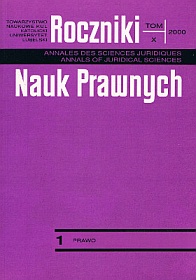Konstrukcja zastawu rejestrowego na tle unormowań kodeksu cywilnego
Abstrakt
De lege lata pledge by registration in its principal construction does not depart from the norms intended in the Civil Code, art. 306 C. C. In order to form the pledge by registration it is indispensable to perform a complex legal transaction which consists of a pledging contract and of a costitutive entry in register of pledges.
The norm resulting from art. 11. u.o.z.r. (Pledge by registration Act) and restricting the range of entitlements of the pledger related to the subject of the pledge has the character ius cogentis and constitutes an example of restrictions of property right resulting directly from the act. Therefore the pledging contract of obligation relationships between parties cannot come into being. Ratio legis of introducing restrictions upon using the subject of pledge by the pledger results in preserving the sale value of this subject. The claims which are due to the creditor on these grounds constitute preventive protection of the pledge by registration.
De lege ferenda to introduce the pledge by registration, a construction should be brought into existance as intended in art. 29 of reat estate mortgage as well as land and mortgage register Act, with a simultaneous change of art. 2, part 2. u.o.z.r. which restricts the application of regulations of the pledge by registration and on entry in a register of pledges Act, to the situation where the subject of the pledge remains in the possession of the pledger or of the third party.
Copyright (c) 2000 Roczniki Nauk Prawnych

Utwór dostępny jest na licencji Creative Commons Uznanie autorstwa – Użycie niekomercyjne – Bez utworów zależnych 4.0 Międzynarodowe.


